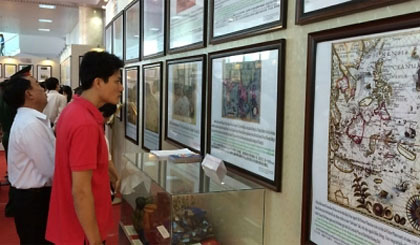Materials prove Vietnam's island ownership in East Sea
An exhibition documenting Vietnam’s sovereignty over Hoang Sa (Paracel) and Truong Sa (Spratly) archipelagos is ongoing in the southernmost province of Ca Mau, with materials tracing back to the 16th century and a six-volume atlas compiled by a famous Belgian cartographer.
 |
| The exhibition attracts many visitors |
Visitors will catch a glimpse of photos, documents and 100 maps written in Han-Nom (ancient Vietnamese script based on Chinese characters) and French language, mostly published from the 17th - early 20th century.
An extensive archive of administrative documents signed by the Nguyen kings from 1802 to 1945 is also worth seeing, making a testament of Vietnam's ownership of islands in the East Sea.
Noticeably, a Chinese collection of four atlases and 30 maps also proves that Hoang Sa and Truong Sa are beyond the so-called “historical evidence of China”.
World atlas Universel, drawn by the late cartographer Phillippe Vandermaelen and published in 1827, describes that Hoang Sa archipelago belongs to the former Empire of An Nam, now Vietnam.
Vietnam has established and exercised its sovereignty over Hoang Sa and Truong Sa archipelagos without hindrance at least since the 17th century.
According to Vietnam’s feudal state history, thousands of sailors overcame roaring waves and storms to survey sea routes, plant milestones and erect steles affirming national territory in Hoang Sa and Truong Sa archipelagos, and mine marine resources as ordered by Nguyen Lords. Their missions were full of dangers, and many of them never returned to land.
The event will run until October 1.
(Source: nhandan.org.vn)
 về đầu trang
về đầu trang







